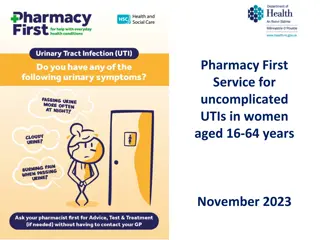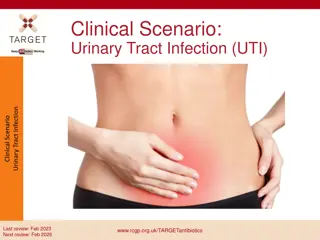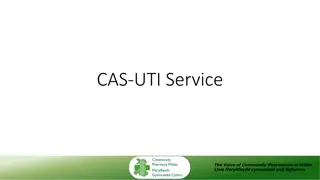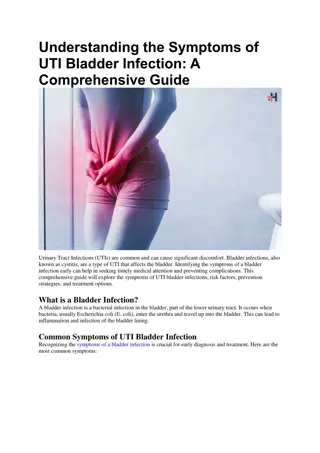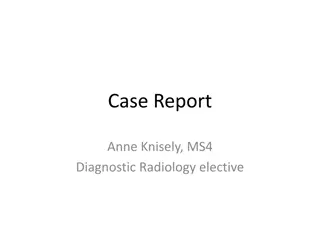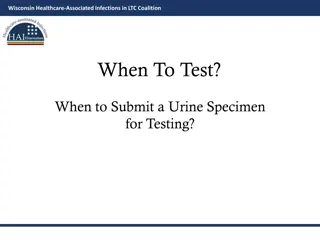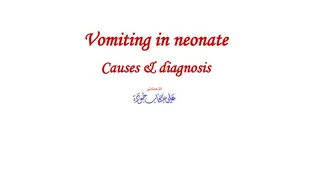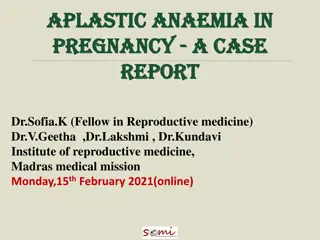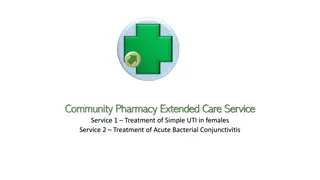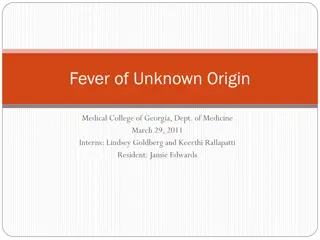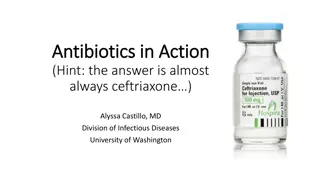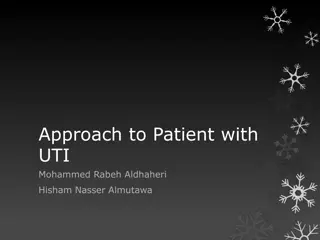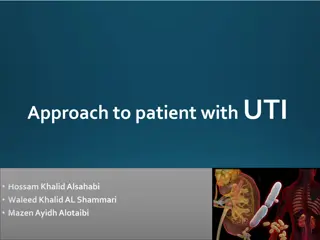
Urinary Tract Infections in Children: Diagnosis and Management
Urinary tract infections (UTIs) are common bacterial infections in children, with Escherichia coli being a primary cause. Learn about the spread, risk factors, recurrence, and prevention of UTIs in pediatric patients to ensure proper diagnosis and effective management strategies are in place.
Uploaded on | 2 Views
Download Presentation

Please find below an Image/Link to download the presentation.
The content on the website is provided AS IS for your information and personal use only. It may not be sold, licensed, or shared on other websites without obtaining consent from the author. If you encounter any issues during the download, it is possible that the publisher has removed the file from their server.
You are allowed to download the files provided on this website for personal or commercial use, subject to the condition that they are used lawfully. All files are the property of their respective owners.
The content on the website is provided AS IS for your information and personal use only. It may not be sold, licensed, or shared on other websites without obtaining consent from the author.
E N D
Presentation Transcript
Urinary tract infections in Urinary tract infections in children children an overview of diagnosis and management
Urinary tract infection (UTI) is one of the most common bacterial infections in childhood. In the first year of life, it is more common in boys (3.7%), as compared to girls, (2%) and after infancy, it is significantly more prevalent in girls. Approximately 85% to 90% of UTIs are caused by Escherichia coli. Other common organisms include Klebsiella, Proteus, Enterococcus, and Enterobacter species
The usual trajectory of UTI spread involves the ascension of periurethral organisms through the urethra into the bladder (cystitis). These uropathogens then migrate upwards through the ureters to the renal parenchyma (pyelonephritis) and may be followed by haematogenous spread (bacteraemia). Pyelonephritis is associated with renal parenchymal scarring in approximately 10 30% of paediatric patients with febrile UTI. Renal scars can result in hypertension, chronic kidney disease (CKD), and subsequently end-stage kidney disease
RISK FACTORS FOR UTI female sex (or uncircumcised infant boy) Younger age white race high-grade VUR CAKUT BBD instrumentation of the urinary tract (particularly indwelling bladder) Administration of an antibiotic may increase the risk of UTI by changing periurethral microflora Genetic factors also influence the occurrence of UTI
The risk of UTI recurrence in the first 6 to 12 months after the initial UTI is 12% to 30% nongenetic factors constipation severe acute malnutrition obstructive uropathy, &urolithiasis& Vesicoureteral reflux (VUR) absent circumcision in boys and female sex genetic factors Predisposition to recurrence of UTI has recently been linked to genetic factors; the identified genes were TLR2, TLR4 ,HSPA 1B, CXCR1, CXCR2,, and TGF- 1.6
PREVENTION OF RECURRENT UTI Recurrent UTI can be prevented by : Bladder and Bowel Dysfunction daytime urinary incontinence, squatting and other holding maneuvers, prolonged or fractionated voiding, increased urine residual volumes, constipation, increased risk of UTI increased oral fluid helps flush bacteria from the bladder, prompts frequent urination In uncircumcised boys, gentle, daily retraction and cleaning should be performed; in boys with phimosis, topical corticosteroid ointment or circumcision may be necessary to prevent UTI recurrence. cranberry juice(no evidence in children)
Differentiation of APN from cystitis can be difficult particularly in preverbal children Because most cases of APN are due to ascending infection, many patients have both upper- and lower-tract symptoms both the acute management and subsequent workup of cystitis and pyelonephritis may differ unlike APN that needs second- or third-generation cephalosporin for at least 1 week, uncomplicated (nonfebrile) bacterial cystitis generally responds well to the short duration (3 5 days) of first generation cephalosporin, trimethoprim-sulfamethoxazole, or nitrofurantoin. The evidence suggests that an increased serum C-reactive protein or procalcitonin level is suggestive of APN. The erythrocyte sedimentation rate does not appear useful in diagnosing APN.
COMPLICATIONS OF UTI Acute complications of UTI are similar to those associated with any febrile illness in a young child. These include : dehydration electrolyte abnormalities febrile seizures Renal complications of APN are uncommon in otherwise healthy children but may include renal abscess Acute kidney injury may occur because of dehydration or an administration of a nonsteroidal anti-inflammatory antibiotic Urosepsis (particularly with Gram negative infections)
The most consequential long-term complication of APN is renal scarring. The reported prevalence of renal scarring after febrile UTI is 15% and ranges from 3% after the first UTI to 29% after> 3 febrile UTIs. In most children, renal scarring may not be clinically significant, but it may cause hypertension and proteinuria and a progressive decline in renal function in those with bilateral significant scarring. Delayed initiation of antibiotic treatment is associated with Delayed initiation of antibiotic treatment is associated with increased risk of scarring increased risk of scarring
RISK FACTORS FOR RENAL SCARRING high grade of VUR (grades >2 and particularly grades 4 and 5) duration of fever of >72 hours before antibiotic initiation recurrent UTI organisms other than E coli differentiation between congenital(renal dysplasia) and acquired scarring after APN is challenging, particularly when baseline (ie, pre- UTI) studies are not available. It has long been speculated that there is a genetic predisposition in some children to develop renal scarring after APN.
Guideline in diagnosis & management & treatment of UTI National Institute for Health and Clinical Excellence (NICE) UK American Academy of Pediatrics (AAP) Canadian Paediatric Society (CPS) European Society for Paediatric Urology Spanish Association of Paediatrics
DIAGNOSIS OF UTI A targeted history and physical examination and positive urinary findings are essential for an accurate diagnosis of UTI. Clinical features of paediatric UTI are remarkably non-specific, especially in younger children. A calculator was recently developed to help clinicians estimate the probability of UTI in febrile infants It is based on 5 risk factors that include : age <12 months white race female sex (or uncircumcised boy) maximum temperature >39 C the absence of another source for fever
History Younger preverbal children cannot report symptoms such as dysuria or abdominal pain. Parents often notice non-specific signs, such as lethargy, irritability, poor feeding and vomiting. These overlap with many common and benign viral infections, as well as serious bacterial infections. Fever is often present, may be the only feature present or the child may be afebrile. Malodorous or discoloured urine may be obscured in nappy-wearing children. Older children may report localizing symptoms such as dysuria or flank pain.
physical examination: Relevant signs on abdominal examination include distention, presence of a mass or palpable stool, flank or suprapubic tenderness, and/or a palpable bladder, particularly after voiding. As clinical diagnosis is unreliable, a urine sample is required for further evaluation
Urine sample collection: precontinent children Non-invasive methods involve waiting for spontaneous urine voiding, then opportunistic collection with a nappy pad and bag clean catch ( lowest contamination of all non-invasive methods ) Quick-Wee method of urine collection(suprapubic area is stimulated by using a gauze soaked in cold fluid) pads and bags have high rates of contamination Pad and bag samples can be useful for dipstick screening but are unreliable for culture. Invasive methods extract urine directly from the bladder by urethral catheterisation suprapubic needle aspiration (SPA). These methods are more reliable for culture and diagnosis
The optimal collection method remains controversial In the UK, where general practitioners provide primary care, guidelines recommend clean catch or other non-invasive methods if clean catch is not possible, and catheter or SPA only if non- invasive methods are not possible or practical. In the USA, where paediatricians often provide primary care, guidelines recommend the opposite, that catheter or SPA is required to confirm UTI, though convenient methods such as urine bags can be used for Screening. Most international guidelines recommend catheter or SPA as the gold standard, include clean catch as an acceptable collection method, and specifically discourage the use of bag samples for culture. A two-step process using initial bag screening and catheter confirmation of positive screens can reduce the rate of invasive procedures
Urinalysis: (dipstick and microscopy) Screening dipstick Urine dipsticks are a quick, inexpensive bedside screening tool. Chemical reagent strips change colour in the presence of leucocyte esterase (an enzyme present in leucocytes) and nitrites(Most uropathogens convert dietary nitrates into urinary nitrites) which may arise from UTI. Dipsticks are also less reliable in young infants, where frequent voiding flushes substrates out of the bladder. leucocytes or nitrites are a useful screening test, particularly when used in combination. If UTI is thought unlikely, dipsticks have a good negative predictive value to exclude the diagnosis. In the presence of suggestive symptoms and either leucocytes or nitrites, empirical antibiotics while awaiting culture is indicated.
Microscopy Leucocytes and bacteria generally appear in the urine in response to UTI. However, sterile pyuria can occur with other infections. requiring pyuria for diagnosis has recently been questioned Enterococcus Klebsiella Pseudomonas species are also less likely to produce pyuria than E.coli in children with symptomatic UTI.
Urine culture: (the gold standard for UTI diagnosis) The acceptable colony count threshold for a urine culture positive for UTI depends on its collection method 50 000 colony-forming units (CFUs)/mL for samples obtained by catheterization 100 000 for samples obtained by clean catch 1000 CFU/mL on samples obtained by suprapubic aspiration The 2011 American Academy of Pediatrics (AAP) guideline defines UTI by the presence of at least 50 000 CFU/mL of a uropathogen in a specimen obtained by bladder catheterization in a child with either a positive result on a leukocyte esterase test or with white blood cells in the urine on microscopy (ie, pyuria) Several studies have revealed that some children with lower colony counts have true UTIs and even we recommend using the AAP guideline: in combination with clinical judgement
COMMON ERRORS IN THE DIAGNOSIS OF UTI Contaminated urine specimen: A diagnosis of UTI based on contaminated urine specimen may lead to unnecessary antibiotic treatment or delayed treatment in those with true UTIs. The contamination rates of bag urine specimens can be as high as 80%. The 2 most common sources of urine contamination are feces and skin suggestive of contamination: Presence of >10 per high-power field squamous epithelial cells on urinalysis insignificant bacterial colony count the presence of >2 pathogens on urine culture in midstream urine specimen Growth of nonuropathogens such as Lactobacillus, Corynebacterium, viridans streptococci, or coagulasenegative staphylococci such as Staphylococcus epidermidis
Asymptomatic bacteriuria (ABU): Colonization of the bladder in the absence of an inflammatory reaction occurs at all ages, including infants and children. Asymptomatic bacteriuria (ABU) is the finding of positive cultures ( 105 colony-forming units of bacteria per mL of urine) of the same uropathogen from 2 consecutive urine samples, in the absence of urinary symptoms. ABU is more common in girls and generally involves Gram negative bacteria, such as E coli. ABU generally involves Gram-negative bacteria, such as Escherichia coli; however, the ABU- related bacterial strains express fewer virulence factors than those bacterial strains involved in febrile UTI, and have been found to have different genes that encode for the production of fimbriae, which are important for the ability of E coli to ascend in the urinary tract .
ABU is frequently observed in children with neurogenic bladder, particularly if the patient is on clean intermittent catheterization or has a history of bladder augmentation Its reported incidence is 1% to 3%, and it usually resolves spontaneously in a few months to a couple of years, although in some girls, it may persist for much longer. Antibiotic treatment is not recommended for otherwise healthy individuals with ABU because its use promotes antimicrobial resistance and other adverse effects, including the possibility of an increased risk of symptomatic UTI.
Sterile pyuria: Sterile pyuria may occur in condition such as : partially treated UTI appendicitis tuberculosis, or fungal, viral, or parasitic infections immunologic conditions such as acute glomerulonephritis, systemic lupus erythematosus, and Kawasaki disease foreign body kidney stones interstitial nephritis and papillary necrosis and analgesic nephropathy
RENAL IMAGING AFTER UTI Renal imaging after UTI is driven primarily by a need to rule out an underlying renal or urinary tract anomaly or the assessment of renal injury. Top-down approach recommends RBUS and DMSA renal scan as initial radiological investigations Bottom-up approach recommends VCUG as the initial radiological investigation Historically, guidelines recommended aggressive imaging follow-up to identify renal scarring and complications from UTI. but, many recent guidelines suggest less or no imaging after first uncomplicated UTI for older children and less aggressive imaging after recurrent UTI
Ultrasound Ultrasound is non-invasive, relatively inexpensive and an appropriate first-line investigation when imaging is indicated. Ultrasound can detect anatomical abnormalities and hydronephrosis or hydroureter suggesting obstruction or VUR. Particular findings on RBUS that may indicate a higher probability of VUR include: ureteral dilation renal parenchymal changes bladder abnormalities
The RBUS can be deferred until after resolution of the UTI but should be considered during the acute episode if the illness seems unusually severe or if high fevers persist beyond 48 to 72 hours of treatment. The NICE guidelines suggest that children aged over 6 months with their first uncomplicated UTI require no investigations following the first urinary tract infection and that children under 6 months should have an ultrasound only. The AAP and ISPN guidelines recommend that all infants aged 2 24 months with febrile UTIs should undergo ultrasounds
Voiding Cystourethrogram In the last decade, the practice patterns have dramatically shifted, with far fewer patients undergoing VCUG after an initial UTI This trend is consistent with many published guidelines, including those by the AAP. Part of the reason for this is that less than one-third of children with their first UTI have VUR, and of these, fewer than 10% have grade 4 to 5 VUR. None of recent guidelines recommend routine VCUG or DMSA scans A VCUG should be considered after first UTI in children with: abnormal RBUS atypical causative pathogen complex clinical course (ill and fails to respond to antibiotics) known renal scarring family history of VUR or CAKUT or recurrent infection
DMSA Renal Scan DMSA scan is the current gold standard for assessment of renal parenchymal injury in a child with a history of febrile UTI. Cortical defects on DMSA scan performed during or shortly after APN may be due to: preexisting lesions (either acquired or congenital) the acute inflammatory reaction associated with APN. A delayed DMSA scan at 4 to 6 months allows the acute inflammatory reaction to subside, But in the absence of baseline (pre-APN) scans, it may still be difficult to differentiate acquired from congenital lesions
most children with first febrile UTI do not need a DMSA renal scan None of recent guidelines recommend routine DMSA scans So It is rarely required acutely but may help guide long-term management. DMSA may be indicated if UTI is: atypical recurrent or initial ultrasound is significantly abnormal Findings of renal scarring may influence surgical decision.
ANTIBIOTIC TREATMENT The choice of an antimicrobial for empirical therapy should be guided by the local, resistant patterns of uropathogens. Which Antibiotic Should Be Used? Generally initial coverage is aimed at treating E. coli infections so empiric antibiotic therapy of acute pyelonephritis often includes a third-generation cephalosporin. More than 50 % of organisms implicated in UTI are now resistant to ampicillin, while about 30 % of organisms are resistant to trimethoprim and first-generation cephalosporins . However, ampicillin remains an important treatment for UTIs due to Enterococcus species, which cause about 6 % of UTIs, with much higher rates in neonates, and show 100 % resistance to cephalosporins .
UTIs, due to multiresistant extended spectrum beta-lactamase (ESBL)-producing E. coli organisms, are becoming more common due to: previous admissions cephalexin for antibiotic prophylaxism previous treatment with third-generation cephalosporins or fluoroquinolones
By Which Route Should Antibiotics Be Administered in a Child with Pyelonephritis? There was no significant difference in the risk of kidney damage on DMSA scan 6 12 months after UTI treatment between children treated with oral antibiotics for 10 14 days and children treated with intravenous antibiotics for 3 4 days followed by oral antibiotics Similarly there was no significant difference in the risk of kidney damage on DMSA scan 3 12 months after UTI treatment between children treated with intravenous antibiotics for 3 4 days followed by oral antibiotics and children treated with intravenous antibiotics for 7 14 days
Based on these studies, the majority of children with acute pyelonephritis may be treated with oral antibiotics or with short courses of intravenous antibiotics followed by oral antibiotics. These results may not be applicable to all children with acute pyelonephritis as children aged below 1 3 months children, who were considered to be severely ill were generally excluded from trials.
For How Long Should a Child with UTI Receive Antibiotics? Guidelines suggest that children with acute pyelonephritis should be treated for 7 14 days or 7 10 days . In children with acute cystitis, short courses (2 4 days) of antibiotic therapy are as effective as longer courses (7 10 days) for clearance of bacteria on urine culture based on systematic reviews of randomized controlled trials
ROLE OF ANTIMICROBIAL PROPHYLAXIS Earlier guidelines recommended that antibiotics be given to children with VUR or recurrent infections to prevent further UTI reported mixed results, with some concluding that prophylaxis is effective and others reporting that prophylaxis offers no or little advantage for the prevention of UTI recurrence These variations in results have been attributed to significant differences in study designs, including patient inclusion and exclusion criteria No study has demonstrated any beneficial effect of antimicrobial prophylaxis for the prevention of renal scarring
factors that should be considered before initiating long-term antimicrobial prophylaxis include : Antibiotic resistance (major risk of long-term prophylaxis) the status of toilet training anticipated compliance with daily medication administration the medication expense parental choice
younger age is a particular consideration for prophylaxis because of: a nonspecific clinical presentation for UTI the difficulty in getting urine specimens the higher possibility of a need for hospitalization for intravenous antibiotic administration and Hydration and septicemia The duration of prophylaxis depends on multiple factors and may range from a few days until a VCUG can be obtained in those recently diagnosed with UTI to a few years for children with VUR on medical management.
In cases of febrile UTI and VUR, the American Urological Association recommends continuous antibiotic prophylaxis in children aged<1 year and a selective approach in older children based on patient age, severity of VUR, recurrence of UTI, presence of BBD, and renal cortical Anomalies. The European Association of Urology, European Society of Pediatric Urology, and Swedish and Italian Society of Pediatric Nephrology also recommend a more selective approach based on a combination of patient age, severity of VUR, and renal scarring. Therefore, antibiotic prophylaxis should not be used routinely but should be reserved for children at high risk of recurrent UTI or those whose index infection is severe.
SURGICAL INTERVENTION FOR VUR Few patients diagnosed with VUR after UTI need surgical correction. It is usually reserved for patients with: high grade VUR recurrent UTI despite antibiotic prophylaxis for the worsening of renal scars Open ureteral reimplantation remains the mainstay of surgical correction for VUR, endoscopic treatment(bulking agent [dextranomer and hyaluronic acid [Deflux). The decision for timing and the type of intervention is based on the age of the patient, status of the kidneys, grade of VUR, and parental wishes
CONCLUSIONS uncontaminated urine specimen is essential for the accurate diagnosis of UTI in children. Most children with first febrile UTI do not need a VCUG, but an early VCUG is appropriate in some patients.
Prompt antibiotic treatment reduces morbidity and the risk of renal scarring. Oral antibiotic administration for 7 to 10 days is sufficient to eradicate infection in those with a good clinical response. A selective use of antimicrobial prophylaxis is considered in patients with recurrent UTI and those with a high risk of renal scarring.

